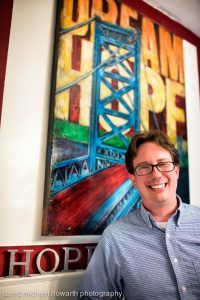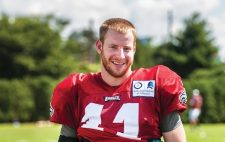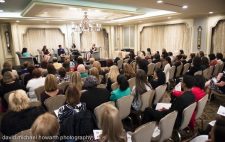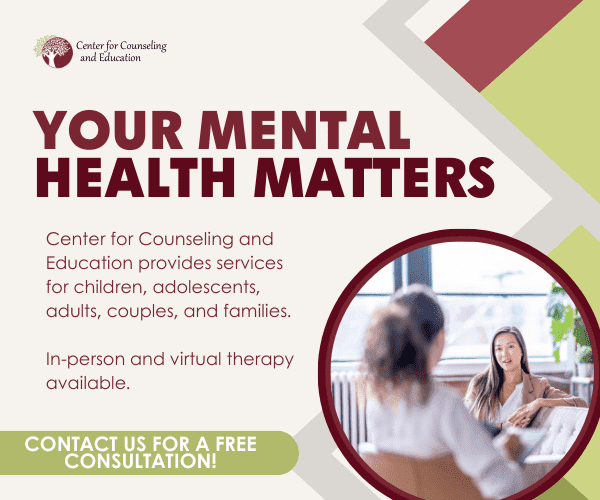
Hopeworks ‘N Camden Youth Healing Team members Annye Fussel, Gemyra Wynn (standing) and LeBaron Harvey
Photography by David Michael Howarth
Say hello to Billy. Billy is a young boy, lost somewhere in that space between boy and man. Billy probably has a television show he hates missing, a favorite sweatshirt that’s worn in just right, but the most noticeable thing about Billy is that he lashes out when anyone touches him. It’s because his father abused him, but you couldn’t possibly know that just by looking at Billy, so everyone thinks he’s angry, violent or both.
Billy, though, is just a made-up name – a made-up person, too, explains LeBaron Harvey, but his stories are real. Harvey, 15, tells these stories as a member of Hopeworks ’N Camden’s Youth Healing Team, part of the nonprofit that’s been working with Camden youth for more than 15 years. The team, comprised entirely of youth with adverse childhood experiences, gives presentations about trauma and its influence on development and lifespan.
The team usually presents to nonprofits, school districts and healthcare providers – the kinds of individuals often on the front lines when it comes to trauma. After training more than 900 people, the team’s reputation travels by word of mouth, says Hopeworks ’N Camden Executive Director Dan Rhoton, and organizations approach Hopeworks looking for assistance.
The stories about the boy named Billy, Harvey says, are a useful tool in those presentations. Though the members of the team have their own stories, they often find it’s easier to share tales that aren’t exactly their own – they may be similar, but there’s a different name, a different place, something that provides a little distance.
“They don’t talk about their own experiences,” says Rhoton. “It makes it very ineffective. When young people talk about their own experiences, people don’t learn the material, they just think, ‘Oh that poor person’ and think it doesn’t apply to them, but it applies to all of us.”
Instead, Rhoton says, the team, started in 2013, has developed different tactics to meet its goal of teaching people how to more effectively work with individuals who have experienced trauma.
That trauma is referred to as an ACE – adverse childhood experience – says team supervisor Victoria Daggan, a graduate student at Rutgers-Camden. The ACE survey has 10 questions meant to gauge traumatic experiences in someone’s life. The survey asks if you’ve ever lost a parent, if a parent has ever been too drunk or high to take you to school, if you have ever watched a parent be assaulted. A score is then assigned based on the number of times you answered “yes.”
The typical score in Camden is five, Daggan says, but most youth on the team have a six or seven. As a trauma-informed organization, Rhoton says, it’s important to let the team members develop their own activities and presentations. And, in the long run, he adds, it’s much more effective than anything else they’ve tried.
The team develops those activities – and completes all the tedious research – on their own. Daggan oversees the team and helps when needed, but says she doesn’t even like using the term “supervisor” since the youth are so proficient.

Hopeworks ‘N Camden Executive Director Dan Rhoton
One of those activities is the balloon game, explains Gemyra Wynn, 17, which demonstrates the difference between someone from a poverty-stricken household and someone from a more fortunate one. There’s also the cup game.
“Two volunteers come and stack up the cups as high as they can, and myself and another member knock down the cups,” Wynn says. “That represents how ACEs come in and destroy their goals.”
Thanks to Hopeworks, however, Wynn is confident her ACE won’t limit her. The 17-year-old wants to be a vet tech one day and says being on the team gives her a great professional background.
“I’ll have to be around a lot of trauma and learn to help others within that career field,” Wynn says. “So it was great for me to join. Just because I have that ACE doesn’t mean it’s a limitation on things I can do.”
Some of the teens talk about their ACEs; others don’t. Harvey says his experience was similar to a lot of his co-workers. His dad was often in and out of jail when he was young, which had a “major effect” when he was younger.
When Harvey went to school and saw male teachers, he instinctively disliked or distrusted them – even “kind of hated them,” he says. Instead, Harvey was more willing to bond with female teachers.
But the team helped Harvey open up about his feelings and express them more readily.
“It’s helped me look at the brighter things in the situation,” he adds.
By researching trauma and its impact, the youth are not only able to educate and help others, but they can also slowly unravel and understand themselves better. The support and family-like atmosphere within Hopeworks and the close relationships between Youth Healing Team members allows the youth to share their experiences in a comfortable setting.
“We’re all pretty much close,” Fussell says. “We all understand each other, and we often relate to each other because we all have ACEs.”
Helping the youth express themselves and build relationships is Daggan’s favorite part of her job as team supervisor, she says. When the team members come to Hopeworks, it’s not all just presentation research and practice.
“When they come in, aside from training and helping them develop presentations, it’s being able to build relationships with them, and when they tell you about their day and if they need help,” Daggan says. “That aspect of it is more powerful than helping them train.”
One of the more powerful experiences of taking part in the team is the confidence it builds. Not only are the youth developing 90-minute presentations on the psychology of the brain, Daggan says, they’re also learning about themselves and developing into excellent public speakers.
Daggan often marvels at how the teens can come in after a full day at school and still work diligently on research and presentations.
“I watch them figure out words they don’t even know and research until they want to pull their hair out and put out a presentation that’s professional and that they’re proud of,” Daggan says. “That’s really what becomes the most powerful.”
It’s a life-changing experience for the youth, too. Harvey says he’s learned how to teach people older than him things they don’t know, which is empowering. And he’s not just teaching adults something basic or brushing up on a topic – most people who receive the presentations, Harvey says, are “mindblown, because they’ve never seen something like this.”
“A lot of people ask us how old we are, and then there’s a shock when we tell them,” he says.
“It’s impactful, because normally they wouldn’t expect high school students to be presenting about the brain and trauma and things of that nature,” Fussell adds. “The message you can get across is a lot more powerful because we are children with ACEs.”
Daggan’s favorite part of seeing the team speak is the audience’s reactions – something she watches closely. Seeing clients hit the “aha moment,” she says, is powerful.
And, of course, Daggan loves when others are impressed with the speaking skills of her team – like when her aunt came to visit and couldn’t believe the age of the team members, either.
But for the team members and Daggan, it all comes back to the relationships they build at the Youth Healing Team.
“You become invested in their lives just as much as your own,” she says. “Somethings aren’t easy to hear about, let alone for them to tell you. Becoming invested has really changed that more to a conversation than a counseling session. When they do tell you, you talk through it. With the Youth Healing Team, it’s more about having a good conversation and investing your time in them as much as you invest in yourself.”
And that investment pays off in the mindset of the youth.
“Life’s short,” Harvey says. “Even though you have an ACE or ACEs, it doesn’t have to hold you back. You can be anything you want to be.”













